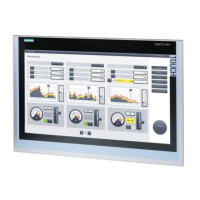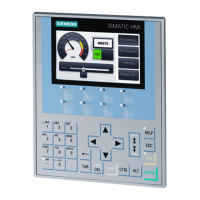6-19
TP27, TP37 Equipment Manual
Release 01/00
6.5.1 Communication Sequence
More than one station (e.g. more than one OP, PU, etc.) on a network can log
on for ALARM_S messages. Each station that wants to display ALARM_S
messages logs on to the CPU for ALARM_S.
OP
S7
CPU
PUTP
CPU
S7
Figure 6-6 MPI Network
When a message–triggering event occurs, the CPU actively sends telegrams to
that effect to all stations that have logged on. The message number identifies
the corresponding message text that has previously been downloaded to the
operating unit.
This means that the CPU does not have to be actively scanned for messages by
regular polling as was the case with the message bit procedure. The operating
unit, CPU and network are completely relieved of that burden on the system.
With the ALARM_S procedure, the time stamp is not issued by the operating
unit but by the CPU. The messages are stored in chronological order on the
basis of their time stamp in the message buffer on the operating unit – even if
they originate from different CPUs.
The CPU stores not only the time of the message but also the status (arrived,
departed, acknowledged) and any process parameters. That information is re-
tained until a message has been completely processed, i.e. until it has arrived,
departed and been acknowledged. On the operating unit, the information in the
message buffer is kept even longer.
Logging On For
ALARM_S
When A Message
Event Occurs
Time Stamp
Information Stored
Messages
